-
INA301-Q1 具有高速过流保护比较器的 36V 汽车类高速、零漂移、电压输出电流分流监视器
- 1 特性
- 2 应用
- 3 说明
- 4 Revision History
- 5 Pin Configuration and Functions
- 6 Specifications
- 7 Detailed Description
- 8 Applications and Implementation
- 9 Power Supply Recommendations
- 10Layout
- 11Device and Documentation Support
- 12Mechanical, Packaging, and Orderable Information
- 重要声明
INA301-Q1 具有高速过流保护比较器的 36V 汽车类高速、零漂移、电压输出电流分流监视器
1 特性
- 符合汽车应用要求
- 具有符合 AEC-Q100 标准的下列特性:
- 器件温度等级 1:–40°C 至 +125°C 的工作环境温度范围
- 器件 HBM ESD 分类等级 2
- 器件 CDM ESD 分类等级 C6
- 提供功能安全
- 宽共模输入范围:0V 至 36V
- 双输出:放大器和比较器输出
- 高精度放大器:
- 失调电压:35 µV(最大值)
- 失调电压漂移:0.5 µV/°C(最大值)
- 增益误差:0.1%(最大值)
- 增益误差漂移:10 ppm/°C
- 可用放大器增益:
- INA301A1-Q1:20 V/V
- INA301A2-Q1:50 V/V
- INA301A3-Q1:100 V/V
- 可编程警报阈值,通过单个电阻器设置
- 总警报响应时间:1 µs
- 透明模式和锁存模式下的开漏输出
- 封装:VSSOP-8
2 应用
- 电磁阀控制
- 低侧电机监控
- 电子动力转向
- 电动座椅
- 电动车窗
- 车身控制模块
- 电子控制单元
- 过流保护
- 电子保险丝
3 说明
INA301-Q1 由高共模电流感测放大器和高速比较器组成,通过测量电流感测或分流电阻两侧的电压并将该电压与定义的阈值限值相比较来提供过流保护。此器件具有一个可调限制阈值范围,此范围由单个外部限值设定电阻器设置。该分流监控器能够在 0V 至 36V 的共模电压范围内测量差分电压信号,与电源电压无关。
开漏报警输出可配置为透明模式(输出状态与输入状态保持一致)或锁存模式(复位锁存时清除报警输出)。器件报警响应时间不到 1 µs,能够快速检测过流事件。
这款器件由 2.7V-5.5V 单电源供电运行,汲取的最大电源电流为 700 µA。该器件在 -40°C 至 +125°C 的扩展级温度范围下额定运行,并且采用 8 引脚 VSSOP 封装。
| 器件型号 | 封装 | 封装尺寸(标称值) |
|---|---|---|
| INA301-Q1 | VSSOP (8) | 3.00mm × 3.00mm |
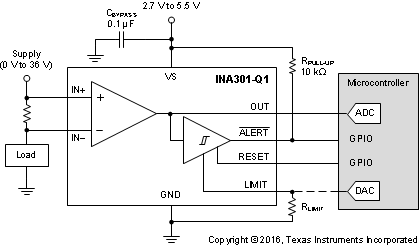 典型应用
典型应用5 Pin Configuration and Functions
| PIN | I/O | DESCRIPTION | |
|---|---|---|---|
| NO. | NAME | ||
| 1 | VS | Analog | Power supply, 2.7 V to 5.5 V |
| 2 | OUT | Analog output | Output voltage |
| 3 | LIMIT | Analog input | Alert threshold limit input; see the Section 7.3.2 section for details on setting the limit threshold. |
| 4 | GND | Analog | Ground |
| 5 | RESET | Digital input | Transparent or latch mode selection input |
| 6 | ALERT | Digital output | Overlimit alert, active-low, open-drain output |
| 7 | IN– | Analog input | Negative voltage input. Connect to load side of the shunt resistor. |
| 8 | IN+ | Analog input | Positive voltage input. Connect to supply side of the shunt resistor. |
6 Specifications
6.1 Absolute Maximum Ratings
| MIN | MAX | UNIT | ||
|---|---|---|---|---|
| Supply voltage, VS | 6 | V | ||
| Analog inputs (IN+, IN–) | Differential (VIN+) – (VIN–)(2) | –40 | 40 | V |
| Common-mode(3) | GND – 0.3 | 40 | ||
| Analog input | LIMIT pin | GND – 0.3 | (VS) + 0.3 | V |
| Analog output | OUT pin | GND – 0.3 | (VS) + 0.3 | V |
| Digital input | RESET pin | GND – 0.3 | (VS) + 0.3 | V |
| Digital output | ALERT pin | GND – 0.3 | 6 | V |
| Operating temperature, TA | –55 | 150 | °C | |
| Junction temperature, TJ | 150 | °C | ||
| Storage temperature, Tstg | –65 | 150 | °C | |
6.2 ESD Ratings
| VALUE | UNIT | |||
|---|---|---|---|---|
| V(ESD) | Electrostatic discharge | Human-body model (HBM), per ANSI/ESDA/JEDEC JS-001(1) | ±2000 | V |
| Charged-device model (CDM), per JEDEC specification JESD22-C101(2) | ±1000 | |||
6.3 Recommended Operating Conditions
| MIN | NOM | MAX | UNIT | ||
|---|---|---|---|---|---|
| VCM | Common-mode input voltage | 12 | V | ||
| VS | Operating supply voltage | 2.7 | 5 | 5.5 | V |
| TA | Operating free-air temperature | –40 | 125 | °C | |
6.4 Thermal Information
| THERMAL METRIC(1) | INA301-Q1 | UNIT | |
|---|---|---|---|
| DGK (VSSOP) | |||
| 8 PINS | |||
| RθJA | Junction-to-ambient thermal resistance | 161.5 | °C/W |
| RθJC(top) | Junction-to-case (top) thermal resistance | 62.3 | °C/W |
| RθJB | Junction-to-board thermal resistance | 81.4 | °C/W |
| ψJT | Junction-to-top characterization parameter | 6.8 | °C/W |
| ψJB | Junction-to-board characterization parameter | 80 | °C/W |
| RθJC(bot) | Junction-to-case (bottom) thermal resistance | N/A | °C/W |
6.5 Electrical Characteristics
| PARAMETER | TEST CONDITIONS | MIN | TYP | MAX | UNIT | |
|---|---|---|---|---|---|---|
| INPUT | ||||||
| VCM | Common-mode input voltage range | 0 | 36 | V | ||
| VIN | Differential input voltage range | VIN = VIN+ – VIN–, INA301A1-Q1 | 0 | 250 | mV | |
| VIN = VIN+ – VIN–, INA301A2-Q1 | 0 | 100 | ||||
| VIN = VIN+ – VIN–, INA301A3-Q1 | 0 | 50 | ||||
| CMR | Common-mode rejection | INA301A1-Q1, VIN+ = 0 V to 36 V, TA = –40°C to +125°C | 100 | 110 | dB | |
| INA301A2-Q1, VIN+ = 0 V to 36 V, TA = –40°C to +125°C | 106 | 118 | ||||
| INA301A3-Q1, VIN+ = 0 V to 36 V, TA = –40°C to +125°C | 110 | 120 | ||||
| VOS | Offset voltage, RTI(1) | INA301A1-Q1 | ±25 | ±125 | µV | |
| INA301A2-Q1 | ±15 | ±50 | ||||
| INA301A3-Q1 | ±10 | ±35 | ||||
| dVOS/dT | Offset voltage drift, RTI(1) | TA= –40°C to +125°C | 0.1 | 0.5 | µV/°C | |
| PSRR | Power-supply rejection ratio | VS = 2.7 V to 5.5 V, VIN+ = 12 V, TA = –40°C to +125°C | ±0.1 | ±10 | µV/V | |
| IB | Input bias current | IB+, IB– | 120 | µA | ||
| IOS | Input offset current | VSENSE = 0 mV | ±0.1 | µA | ||
| OUTPUT | ||||||
| G | Gain | INA301A1-Q1 | 20 | V/V | ||
| INA301A2-Q1 | 50 | |||||
| INA301A3-Q1 | 100 | |||||
| Gain error | INA301A1-Q1, VOUT = 0.5 V to VS – 0.5 V | ±0.03% | ±0.1% | |||
| INA301A2-Q1, VOUT = 0.5 V to VS – 0.5 V | ±0.05% | ±0.15% | ||||
| INA301A3-Q1, VOUT = 0.5 V to VS – 0.5 V | ±0.11% | ±0.2% | ||||
| TA= –40°C to 125°C | 3 | 10 | ppm/°C | |||
| Nonlinearity error | VOUT = 0.5 V to VS – 0.5 V | ±0.01% | ||||
| Maximum capacitive load | No sustained oscillation | 500 | pF | |||
| VOLTAGE OUTPUT | ||||||
| Swing to VS power-supply rail | RL = 10 kΩ to GND, TA = –40°C to +125°C | VS – 0.05 | VS – 0.1 | V | ||
| Swing to GND | RL = 10 kΩ to GND, TA = –40°C to +125°C | VGND + 20 | VGND + 30 | mV | ||
| FREQUENCY RESPONSE | ||||||
| BW | Bandwidth | INA301A1-Q1 | 550 | kHz | ||
| INA301A2-Q1 | 500 | |||||
| INA301A3-Q1 | 450 | |||||
| SR | Slew rate | 4 | V/µs | |||
| NOISE, RTI(1) | ||||||
| Voltage noise density | 30 | nV/√ Hz | ||||
| COMPARATOR | ||||||
| tp | Total alert propagation delay | Input overdrive = 1 mV | 0.75 | 1 | µs | |
| Slew-rate-limited tp | VOUT step = 0.5 V to 4.5 V, VLIMIT = 4 V | 1 | 1.5 | |||
| ILIMIT | Limit threshold output current | TA = 25°C | 79.7 | 80 | 80.3 | µA |
| TA = –40°C to +125°C | 79.2 | 80.8 | ||||
| VOS | Comparator offset voltage | INA301A1-Q1 | 1 | 3.5 | mV | |
| INA301A2-Q1 | 1 | 4 | ||||
| INA301A3-Q1 | 1.5 | 4.5 | ||||
| VHYS | Hysteresis | INA301A1-Q1 | 20 | mV | ||
| INA301A2-Q1 | 50 | |||||
| INA301A3-Q1 | 100 | |||||
| VIH | High-level input voltage | 1.4 | 6 | V | ||
| VIL | Low-level input voltage | 0 | 0.4 | V | ||
| VOL | Alert low-level output voltage | IOL = 3 mA | 70 | 300 | mV | |
| ALERT pin leakage input current | VOH = 3.3 V | 0.1 | 1 | µA | ||
| Digital leakage input current | 0 ≤ VIN ≤ VS | 1 | µA | |||
| POWER SUPPLY | ||||||
| IQ | Quiescent current | VSENSE = 0 mV, TA = 25°C | 500 | 650 | µA | |
| TA = –40°C to +125°C | 700 | |||||
6.6 Typical Characteristics
at TA = 25°C, VS = 5 V, VIN+ = 12 V, and alert pullup resistor = 10 kΩ (unless otherwise noted)
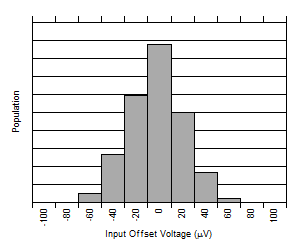
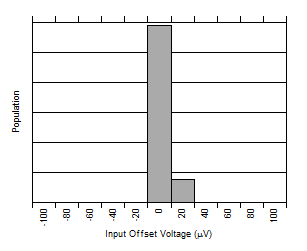
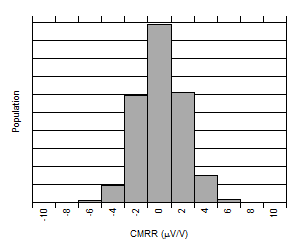
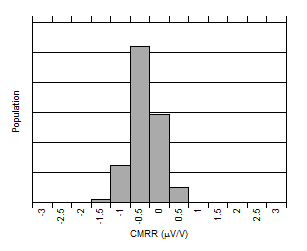

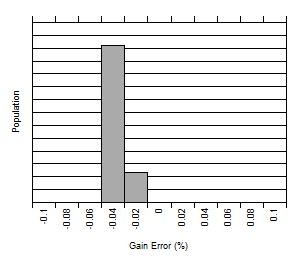
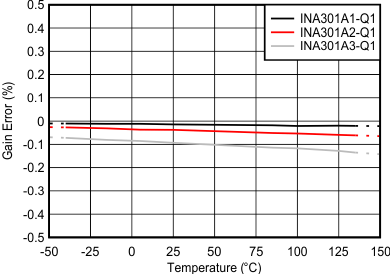
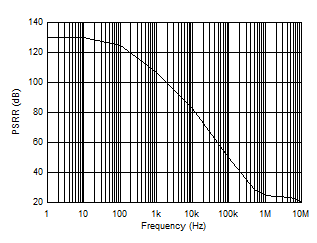
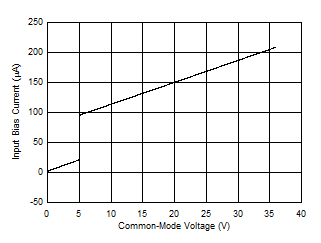
| VS = 5 V |
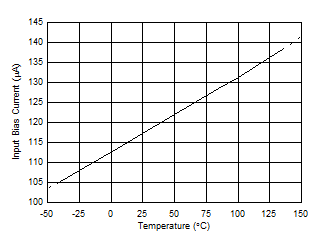
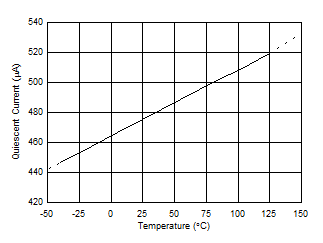
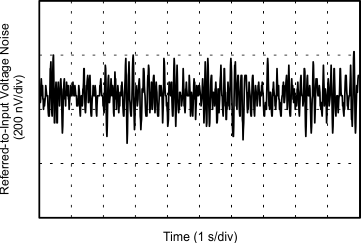
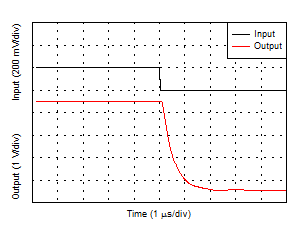
| 4-VPP output step |
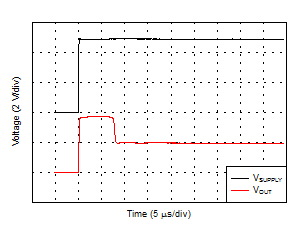
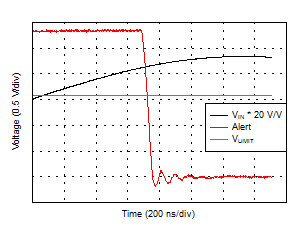


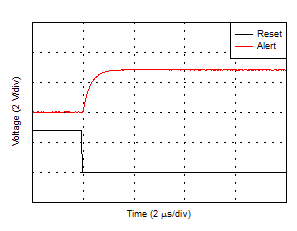
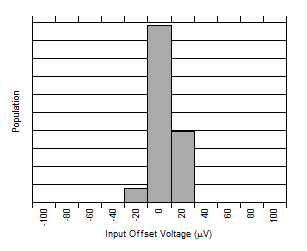
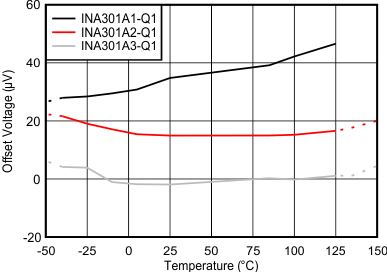
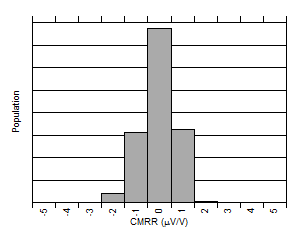
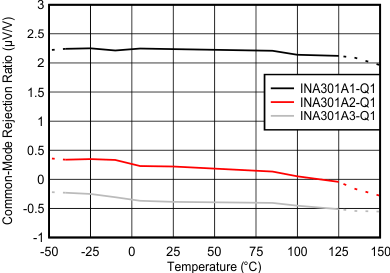
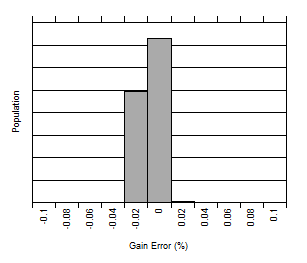
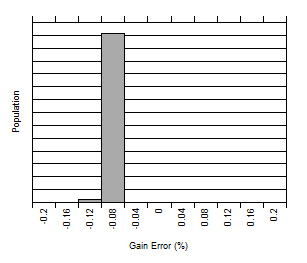
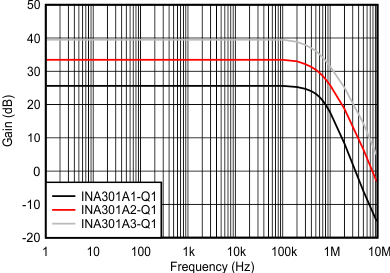
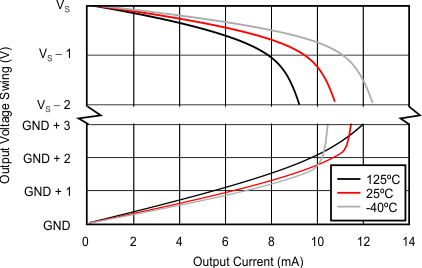
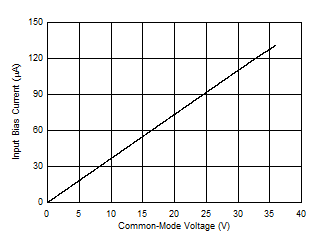
| VS = 0 V |
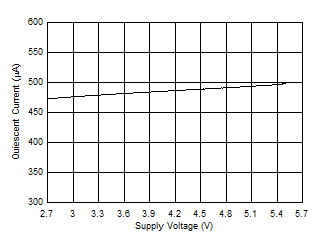
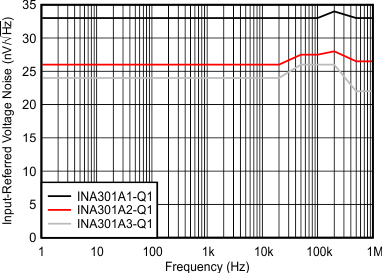
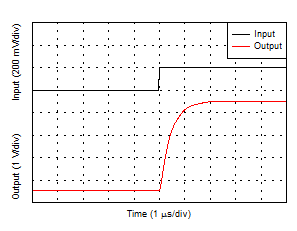
| 4-VPP output step |
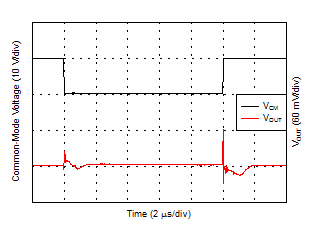
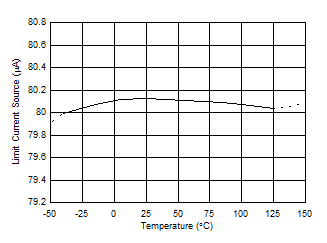
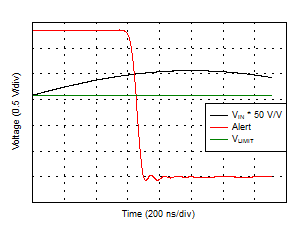

| VOD = 1 mV |
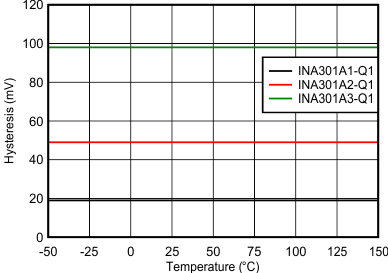
7 Detailed Description
7.1 Overview
The INA301-Q1 is a 36-V common-mode, zero-drift topology, current-sensing amplifier that can be used in both low-side and high-side configurations. These specially-designed, current-sensing amplifiers are able to accurately measure voltages developed across current-sensing resistors (also known as current-shunt resistors) on common-mode voltages that far exceed the supply voltage powering the device. Current can be measured on input voltage rails as high as 36 V, and the device can be powered from supply voltages as low as 2.7 V. The device can also withstand the full 36-V common-mode voltage at the input pins when the supply voltage is removed without causing damage.
The zero-drift topology enables high-precision measurements with maximum input offset voltages as low as 35 μV with a temperature contribution of only 0.5 μV/°C over the full temperature range of –40°C to +125°C. The low total offset voltage of the INA301-Q1 enables smaller current-sense resistor values to be used, and allows for a more efficient system operation without sacrificing measurement accuracy resulting from the smaller input signal.
The INA301-Q1 uses a single external resistor to allow for a simple method of setting the corresponding current threshold level for the device to use for out-of-range comparison. Combining the precision measurement of the current-sense amplifier and the onboard comparator enables an all-in-one overcurrent detection device. This combination creates a highly-accurate solution that is capable of fast detection of out-of-range conditions, and allows the system to take corrective actions to prevent potential component or system-wide damage.
7.2 Functional Block Diagram
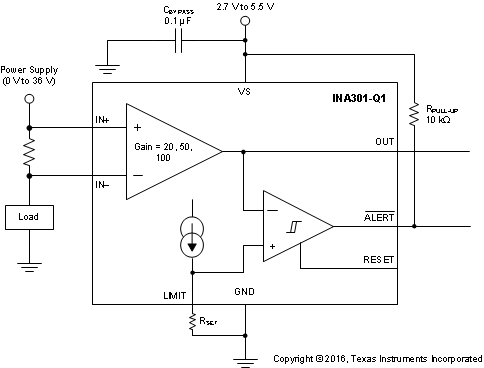
7.3 Feature Description
7.3.1 Alert Output ( ALERT Pin)
The device ALERT pin is an active-low, open-drain output that is designed to be pulled low when the input conditions are detected to be out-of-range. Add a 10-kΩ pullup resistor from ALERT pin to the supply voltage. This open-drain pin can be pulled up to a voltage beyond the VS supply voltage, but must not exceed 5.5 V.
Figure 7-1 shows the alert output response of the internal comparator. When the output voltage of the amplifier is less than the voltage developed at the LIMIT pin, the comparator output is in the default high state. When the amplifier output voltage exceeds the threshold voltage set at the LIMIT pin, the comparator output becomes active and pulls low. This active low output indicates that the measured signal at the amplifier input has exceeded the programmed threshold level, indicating an overcurrent or out-of-range condition has occurred.
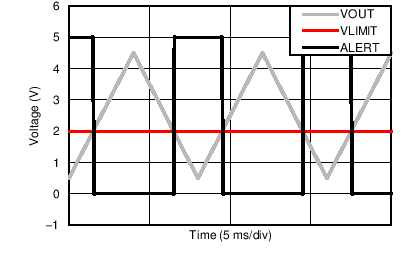 Figure 7-1 Overcurrent Alert Response
Figure 7-1 Overcurrent Alert Response7.3.2 Current-Limit Threshold
The INA301-Q1 determines if an overcurrent event is present by comparing the amplified measured voltage developed across the current-sensing resistor to the corresponding signal developed at the LIMIT pin. The threshold voltage for the LIMIT pin is set using a single external resistor, or by connecting an external voltage source to the LIMIT pin.
7.3.2.1 Resistor-Controlled Current Limit
The typical method for setting the limit threshold voltage is to connect a resistor from the LIMIT pin to ground. The value of this resistor, RLIMIT, is chosen in order to create a corresponding voltage at the LIMIT pin equivalent to the output voltage, VOUT, when the maximum desired load current is flowing through the current-sensing resistor. An internal 80-µA current source is connected to the LIMIT pin to create a corresponding voltage used to compare to the amplifier output voltage, depending on the value of the RLIMIT resistor.
In the equations from Table 7-1, VTRIP represents the overcurrent threshold that the device is programmed to monitor, and VLIMIT is the programmed signal set to detect the VTRIP level.
| PARAMETER | EQUATION | |
|---|---|---|
| VTRIP | VOUT at the desired-current trip value | ILOAD × RSENSE x Gain |
| VLIMIT | Threshold limit voltage | VLIMIT = VTRIP |
| ILIMIT × RLIMIT | ||
| RLIMIT | Threshold limit-setting resistor value | VLIMIT / ILIMIT |
| VLIMIT / 80 µA | ||